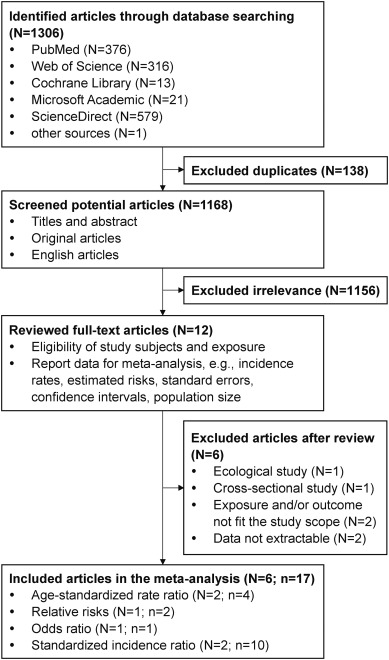Environment International ( IF 10.3 ) Pub Date : 2018-09-24 , DOI: 10.1016/j.envint.2018.09.018 Cheng-Kuan Lin , Yu-Tien Hsu , David C. Christiani , Huei-Yang Hung , Ro-Ting Lin

|
Background
Lung cancer is one of the most common cancers in the world. Higher incidence of lung cancer may be associated with residential proximity to a petrochemical industrial complex (PIC) due to exposure to various carcinogens, although results from previous epidemiologic studies remain inconclusive. Because disease burden due to residential inequality is a public health and societal concern, this study analyzed published data to estimate lung cancer incidence in association with residential proximity to PICs.
Methods
We performed a meta-analysis on selected epidemiologic studies that met the following criteria: lung cancer incidence was coded by the International Classification of Diseases; exposure groups were clearly defined as residents living near PICs; and confidence intervals were available or calculable from original articles. We further applied a population attributable factor (PAF) method to estimate disease burden attributable to living near PICs in 22 European Union (EU) countries.
Results
Meta-analysis included six studies with a total of 466,066 residents living near PICs in six countries. Residents living near PICs had a 19% higher risk of lung cancer compared to those who lived farther away (95% CI = 1.06–1.32). By sex, risks were higher and more significant for females (RR = 1.29; 95% CI = 1.09–1.54; P = 0.004) than males (RR = 1.12; 95% CI = 0.95–1.33; P = 0.173). By location, only groups in Europe had a significantly greater risk of lung cancer with exposure to PICs (95% CI = 1.03–1.33; P = 0.019), although groups in other locations showed similar trends. By bona fide observation, observation of residents for at least seven years provided sufficient latency to estimate risk (RR = 1.25; 95% CI = 1.17–1.34; P < 0.001). Regarding burden of lung cancer in 22 EU countries, 494 males and 478 females were attributed to living in the vicinity of a PIC annually.
Conclusions
Lung cancer incidence is significantly higher in individuals living near PICs. This result provides strong epidemiologic evidence for further policy to regulate potential pollutants near PICs.
Highlights
Higher incident rates of lung cancer for residents living close to petrochemical industry complex
中文翻译:

居民区石化工业园区肺癌发病风险与负担的Meta分析与应用
背景
肺癌是世界上最常见的癌症之一。由于暴露于各种致癌物,肺癌的高发病率可能与居住地靠近石化工业综合体 (PIC) 有关,尽管先前流行病学研究的结果仍无定论。由于居住不平等导致的疾病负担是一个公共卫生和社会问题,本研究分析了已发表的数据,以估计与居民与 PIC 的接近程度相关的肺癌发病率。
方法
我们对符合以下标准的选定流行病学研究进行了荟萃分析:肺癌发病率由国际疾病分类编码;暴露人群被明确定义为居住在 PIC 附近的居民;置信区间可从原始文章中获得或计算。我们进一步应用人口归因因素 (PAF) 方法来估计 22 个欧盟 (EU) 国家居住在 PIC 附近的疾病负担。
结果
荟萃分析包括六项研究,共有 466,066 名居住在六个国家的太平洋岛国附近的居民。与住在更远的居民相比,居住在 PIC 附近的居民患肺癌的风险高 19% (95% CI = 1.06–1.32)。按性别划分,女性 (RR = 1.29;95% CI = 1.09–1.54;P = 0.004) 的风险高于男性 (RR = 1.12;95% CI = 0.95–1.33;P = 0.173)。按地点划分,只有欧洲的人群因接触 PIC 而患肺癌的风险显着增加(95% CI = 1.03–1.33;P = 0.019),尽管其他地区的人群显示出类似的趋势。通过真实观察,对居民至少七年的观察提供了足够的潜伏期来估计风险(RR = 1.25;95% CI = 1.17–1.34;P < 0.001)。关于 22 个欧盟国家的肺癌负担,每年有 494 名男性和 478 名女性归因于居住在 PIC 附近。
结论
居住在 PIC 附近的人的肺癌发病率明显更高。这一结果为进一步制定政策以规范 PIC 附近的潜在污染物提供了强有力的流行病学证据。
强调
石化园区附近居民肺癌发病率较高









































 京公网安备 11010802027423号
京公网安备 11010802027423号